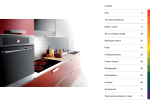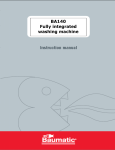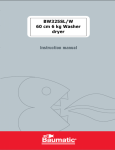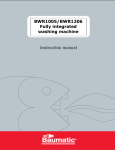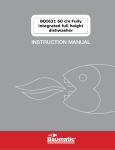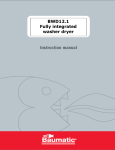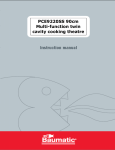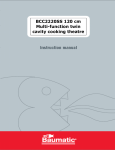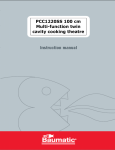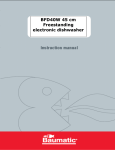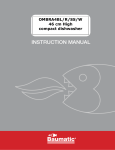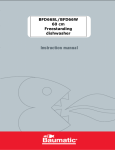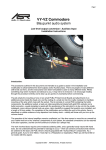Download Baumatic BD696SS dishwasher
Transcript
BD696SS 46 cm High compact dishwasher USER MANUAL FOR YOUR BAUMATIC BD696SS 46 cm High compact dishwasher NOTE: This User Instruction Manual contains important information, including safety & installation points, which will enable you to get the most out of your appliance. Please keep it in a safe place so that it is easily available for future reference; for you or any person not familiar with the operation of the appliance. DD 30/07/09 2 Contents Environmental note 4 Important safety information 5–7 Specifications Product and aperture dimensions Product specifications Energy efficiency details Electrical details 8-9 8 8-9 9 9 Description of the appliance Control panel 9 - 10 10 Using your dishwasher Before first use Filling with dishwasher salt Setting the water softener level Filling with rinse aid Setting the rinse aid level Filling with dishwasher detergent Loading the basket The cutlery basket Loading dishes and cutlery 11 11 11 12 13 14 15 16 17 18 Program table Setting a wash program Changing a wash program At the end of a wash cycle Additional rinse option “3 in 1” key Setting a delay start Rinse aid and salt indicator neons 20 - 26 21 - 22 22 - 23 23 24 24 25 26 Cleaning and maintenance Removing the basket The filter system Cleaning the filters The drip tray Cleaning the spray arm Cleaning the control panel Cleaning the door Cleaning the door gasket Not using the appliance for a prolonged period? Reconnecting the appliance after a period of disuse 26 26 28 29 30 31 31 32 32 32 32 Error code failure system General troubleshooting 33 - 34 35 - 36 Installation Installing the dishwasher into a kitchen cabinet Connecting to the mains water supply Water outlet Power supply Before first use 37 38 39 40 41 42 Contact details 43 - 19 - 12 13 14 15 16 17 - 19 – 32 - 27 – 30 - 31 – 42 – 39 - 41 - 42 3 ENVIRONMENTAL NOTE Note: Before discarding an old appliance, switch off and disconnect it from the power supply. Cut off and render any plug useless. Cut the cable off directly behind the appliance to prevent misuse. This should be undertaken by a competent person. Disable the door lock to make sure that children cannot get stuck inside the appliance. o The packaging materials that Baumatic uses are environmentally friendly and can be recycled. o Please discard all packaging material with due regard for the environment. 4 IMPORTANT SAFETY INFORMATION Your safety is of the utmost importance to Baumatic. Please make sure that you read this instruction booklet before attempting to install or use the appliance. If you are unsure of any of the information contained in this booklet, please contact the Baumatic Advice Line. General Safety o Repairs to your appliance must only be carried out by a Baumatic engineer or one of its authorised service agents. Any attempt by an inexperienced person to repair the appliance, could result in injury or damage to your dishwasher. o If you notice that the mains cable is damaged. The appliance must not be used. The same applies if you notice that the worktop, control panel or base area is damaged. As this could allow access to the internal components of the machine. o The appliance should be turned off and isolated from the mains supply, before either cleaning or maintenance work is attempted. o The mains cable must not be used to pull the plug out of the electrical socket. o The machine should not be sprayed with water. o The external surface of the appliance may become hot whilst your dishwasher is in use. o It is possible for small animals to chew either mains cables or water hoses, which could cause an electric shock hazard. Installation o The installation instructions contained within this user manual should be followed. o It is obligatory for the completed installation to comply with all relevant building regulations and local water authority requirements. o Before the first use of the appliance, you should follow the steps listed in the “Before first use” section on page 11 and page 42 of this manual. 5 o Care should be taken not to trap the power supply cable underneath the appliance whilst installing it. o No attempt should be made to alter or modify the specifications of this appliance. In daily use o This appliance is only designed to wash normal domestic washloads. If you use your dishwasher in any other way or it is incorrectly used, then Baumatic accepts no liability for any damage that might be caused and any guarantee will be void. o It is recommended that the appliance is unplugged and the water supply is turned off after the machine is used. o The detergents, rinse aid and salt that you place in this appliance should be suitable for automatic dishwashers. With regards to dosage levels, the detergent manufacturer’s recommendations should be followed. o Sharp knives or ones with long blades are a potential safety hazard when placed in an upright position in the cutlery basket. We would recommend that these items are placed horizontally in the main basket. o You should not wash any items that have come into contact with corrosive, acidic or alkaline chemicals, paint, petrol, iron or steel debris. o You should not open the door whilst the appliance is set on a wash program. Depending on which stage that the wash program is at, hot water could escape the machine. o You should not leave the door of the appliance open, unless you are loading or unloading the dishwasher. o You should not stand or sit on the door when it is open. 6 Child Safety o Your dishwasher should only be used by adults. You should not allow children in the area of the machine unsupervised. You should not let them touch the controls or play with the appliance. o It could be possible for a child or pet to gain access to the dishwasher if the door is left open. Therefore please check the inside of the appliance before setting it on a wash cycle. o Any packaging that is removed from the machine should be kept away from children. o All detergents should be kept out of children’s reach in a safe place. o Some water will remain inside the dishwasher when it has completed a wash cycle. This water is not suitable for drinking and may contain residues from the detergents that are used in the appliance. Declaration of conformity This appliance complies with the following European Directives: -73/23 dated 19/02/1973 Low Voltage Directive and subsequent modifications. -89/336 dated 03/05/1989 Electromagnetic Compatibility Directive and subsequent modifications. For future reference please record the following information which can be found on the rating plate and the date of purchase which can be found on your sales invoice. The rating plate of your dishwasher is located on the right hand side of the drop down door. Model Number ………………………………. Serial Number ………………………………. Date of Purchase ………………………………. 7 Specifications Product and aperture dimensions Product dimensions Aperture dimensions Height: Width: Depth: Height: 450 Height: 460 (built under) Width: 560 Depth: 560 457 mm 598 mm 568 mm mm mm mm mm Product specifications o 6 Place settings o 5 functions: Normal Intensive Economy Rapid Powerful o 4 Wash temperatures: 40°C, 50°C, 65°C, 70°C o 2 Rinse temperatures: 68°C, 70°C 8 o o o o o o o o o Electronic aqua stop Delay start LED display Residual drying Concealed heating element Mark resistant coating Self-cleaning stainless steel micro-filter Anti-leak device Anti-flood device o Low water consumption (8 litres) o Noise level (49 dB) Energy efficiency details Energy efficiency class: A Washing performance class: A Drying performance class: A Electrical details Rated voltage: Maximum rated input: Supply connection: 230 Vac 50 Hz 1.58 kW 13 A (double pole switched fused outlet with 3 mm contact gap) Description of the appliance Interior of the appliance 9 Control panel A) B) C) C1) D) D1) E) E1) F) G & H) I) J) K) L) M) N) ON/OFF key Program selection key Delay start key Delay start icon Additional rinse key Additional rinse icon “3 in 1” key “3 in 1” icon Start program key Digits Warning icon Salt required icon Rinse aid required icon Wash program icons Wash temperature icons Door locked icon Using your dishwasher Before first use o Install the appliance as per the installation instructions contained within this booklet. o Fill the water softener with 1 litre of tap water and then fill with specialist dishwasher salt. After this you should set the water softener level. o Fill the rinse aid dispenser and then set the rinse aid dosage. Filling with dishwasher salt IMPORTANT: You should only use salt that is specially designed for use in a dishwasher. If any other type of salt is used in the appliance (in particular table salt), it will damage the water softener. o Ideally you should fill the water softener with salt, just before you are about to run a wash program. This will help to clear any salt that may have overflowed from the water softener during the salt filling process. o Open the door of the dishwasher and then unhook the basket from the door. The basket should be empty when you remove it. o Turn the water softener anticlockwise and remove it. cap o Pour 1 litre of water into the water softener. IMPORTANT: It is only necessary to do this when you fill the container with salt for the first time. o Ensure that the supplied positioned correctly. funnel is 11 o Pour salt into the water softener, you should add approximately 1 kg of salt into the water softener. o It is perfectly normal for a small amount of water to come out of the water softener, whilst you are filling it with salt. This does not mean that the water softener is filled with the correct amount of salt. o Refit and fully tighten the water softener cap. o To remove any excess salt that may have spilled out of the water softener, we would recommend that the rapid wash program is completed afterwards. o When the salt required neon (J) lights on the control panel, then you should follow the “filling with dishwasher salt” procedure again. o IMPORTANT: You do not need to pour 1 litre of water into the container when you subsequently fill the water softener with salt. Setting the water softener level It is possible to regulate the amount of salt that the water softener will release during a wash cycle. The water softener should be set to a level that is appropriate for the hardness of your water (please refer to the table below). Display °dH °fH °Clarke mmol/l 0 0–6 0 – 10 0–7 0–1 1 6 – 14 11 – 25 8 – 18 1.1 – 2.5 2 15 – 22 26 – 40 19 – 28 2.6 – 4 3 23 – 28 41 – 50 29 – 35 4.1 – 5.0 4 > 28 > 50 > 35 >5.0 o The dishwasher will leave the factory with the water softener on setting 2. 12 You should adjust the amount of salt that is released by the machine taking into account the water hardness of your geographical area, to do this you should:o Close the door of the dishwasher, you will hear a mechanical click when the door of the dishwasher is shut properly. o Press the ON/OFF key (A) to switch the machine on, the LED display will light up and show “P0”. Immediately press and hold the program selection key (B) until the LED display is showing a flashing “h0”. o To alter the water hardness setting, use the additional rinse key (D) to cycle through numbers 0 – 4. o When the LED display shows the water softener setting that you require, press the program selection button to confirm your choice. The LED display will show “P0” to indicate that the dishwasher is ready to program. o If you live in a soft water area and as a result select setting “0” for the water softener, there is no need to fill the water softener with dishwasher salt. The salt required icon (J) will remain lit. o IMPORTANT: If you are using 3 in 1 dishwasher tablets then it may still be necessary to fill the water softener. You should refer to the instructions given by the dishwasher salt manufacturer. If they suggest using 3 in 1 tablets and separate dishwasher salt, we would recommend that water softener setting 1 is selected. Filling with rinse aid The rinse aid is released during the final rinse and it helps to prevent water from forming droplets on your dishes. These droplets will lead to spots and streaks being left on items after the wash program has completed. o Your dishwasher is designed to utilise liquid rinse aid. o The rinse aid container is located on the inside of the dishwasher door. o To access the rinse aid dispenser, you should turn and remove the cap to reveal the spout. 13 o Slowly pour in liquid rinse aid, the rinse aid dispenser will hold approximately 100ml of rinse aid. o You should continue to fill with rinse aid until the dispenser is full. Be careful not to overfill the dispenser, as this could cause oversudsing when a wash program is selected. Wipe away any rinse aid excess or spillages with a damp cloth. o Replace the cap and turn it until it locks into position. o When the rinse aid required neon (K) lights on the control panel, then you should follow the “filling with rinse aid” procedure again. o IMPORTANT: If you are using 3 in 1 dishwasher tablets then it may still be necessary to fill the rinse aid dispenser. You should refer to the instructions given by the rinse aid manufacturer. Setting the rinse aid level The amount of rinse aid that the dishwasher requires also depends on the hardness of your water. You should experiment with the rinse aid setting, until you find a level that gives the best results. o The dishwasher will leave the factory with the water softener on setting “A1”. o The rinse aid level can only be set whilst the LED display is showing “P0”. o Close the door of the dishwasher, you will hear a mechanical click when the door of the dishwasher is shut properly. o Press the ON/OFF key (A) to switch the machine on, the LED display will light up and show “P0”. Immediately press and hold the delay start key (C) until the LED display is showing “A1”. o To alter the rinse aid setting, use the additional rinse key (D) to cycle through A0 – A2. 14 o When the LED display shows the rinse aid setting that you require, press the program selection button to confirm your choice. The LED display will show “P0” to indicate that the dishwasher is ready to program. o If you get water spots and poor drying performance, then the rinse aid level should be increased to a higher level. o You should continue to increase the rinse aid level until you get no water spots. o If you get cloudiness or streaking on your dishes, the rinse aid level is set too high and it is causing foaming during the wash cycle. The rinse aid level should be decreased to a lower level. Filling with dishwasher detergent The detergent dispenser must be refilled at the start of each wash cycle. o Your dishwasher is designed to use detergent tablets, you should place one per wash cycle in the cutlery basket (in the position shown in the above picture). o If you are not placing the cutlery basket inside the dishwasher on a particular wash cycle, then it is possible to place the detergent tablet in one of the corners of the drip tray (see above picture). 15 o If you are using powder detergent, this should also be placed in one of the corners of the drip tray. You should refer to the manufacturer’s instructions when it comes to the amount of power detergent to use per wash cycle. o IMPORTANT: We do not recommend that you use liquid detergent in this appliance. o IMPORTANT: If you are using “3 in 1” detergent tablets and not also using separate dishwasher salt and rinse aid, then the salt required icon (J) and rinse aid required icon (K) will remain lit. o IMPORTANT: If you are using “3 in 1” detergent tablets and not also using separate dishwasher salt and rinse aid, after selecting your wash program you must press the “3 in 1” key (E). The “3 in 1” icon (E1) will light on the LED display. Loading the basket The basket is designed to wash plates (up to 26 cm in diameter), bowls, glasses, cups, pots, pans, lids, salad bowls etc. Examples of appropriate ways to load the basket are shown in the pictures below. o Loading without saucepans o Loading without plates 16 o Loading with a mixture of plates and saucepans o Saucepans and serving bowls must always be placed with their bases upwards. o Deep saucepans should be slanted, to allow water to run off. IMPORTANT: Care should be taken to make sure that the spray arm can move freely when items have been loaded into the basket. The cutlery basket Cutlery should be placed inside of the cutlery basket. The cutlery basket should then be placed in the appropriate position in the lower basket. 1. 2. 3. 4. 5. 6. 7. Teaspoons Dessert spoons Soup spoons Forks Knives Ladle Serving fork IMPORTANT: Do not allow items of cutlery to fall through the bottom of the cutlery basket, as this may cause damage to the spray arm and/or the cutlery. If the bottom of the basket begins to deteriorate and allows items to fall through, you should replace the cutlery basket. 17 Loading dishes and cutlery Household cloths, sponges or any other object that may absorb water SHOULD NOT be washed in a dishwasher. o Remove leftovers and soften the remnants of burnt food in pans, prior to loading dishes in the appliance. o Once the dishwasher has been loaded, check that the spray arm can move freely. If the spray arm comes into contact with any item, then you should rearrange the wash load. o Cups, glasses, pans etc should all be loaded with their bases upwards, so that water does not collect inside of them. o Cutlery and dishes should not cover each other; otherwise you may get poor wash results. o Do not allow glasses to touch inside the dishwasher, otherwise damage may occur. o Small objects can be placed inside of the cutlery basket. o Sharp knives or ones with long blades are a potential safety hazard when placed in an upright position in the cutlery basket. We would recommend that these items are placed horizontally in the main basket. 18 The following items are NOT suitable for washing inside a dishwasher:o Cutlery with a handle of mother-of-pearl, wood, horn or china. o Plastic items that are not resistant to heat. o Cutlery that consists of glued parts that are not resistant to heat. o Cutlery items or crockery that are bonded. o Copper or pewter items. o Lead crystal glass. o Wooden platters. o Synthetic fibre items. The following items are not always suitable for washing inside a dishwasher:o Stoneware should only be washed if the manufacturer of the item has marked it as dishwasher safe. o Plastic items (such as lunchboxes) should only be washed if the manufacturer has marked it as dishwasher safe. o Glazed crockery may fade with repeated washing inside of a dishwasher. o Items made of silverware or aluminium can discolour when washed inside a dishwasher. o Any food residue should be removed from silver immediately, as this can also result in discolouration. items o Certain types of glass may become dull or cloudy after a large number of washes. 19 Program table Wash program P1 (50°C Economy) LED display information shown P2 (70°C Intensive) P3 (65°C Normal)* P4 (40°C Rapid) P5 (70° Powerful) * Normal is the testing program for EN 50242. Program details Description P1 50°C wash 68°C rinse Drying P2 P3 P4 P5 70°C wash Intermediate rinse (x 2) 70°C rinse 65°C wash Intermediate rinse 70°C rinse 40°C wash Intermediate rinse 70°C rinse 70°C wash Intermediate rinse 70°C rinse Drying Drying Drying Drying Detergent Rinse aid Rinse plus Delay start “3 in 1” option Type of dishes YES YES YES YES YES YES YES YES YES YES YES YES YES YES YES YES YES YES YES YES YES YES YES YES YES Mixed dishes Types of soiling Normal soiling Mixed resistance dishes Heavy soiling (not for delicate items) Mixed delicate dishes Heavy soiling (not for delicate items) Mixed resistance dishes Light soiling Mixed resistance dishes Heavy soiling or using a dishwasher cleaner 20 Opening and closing the door o Pull the dishwasher handle to open the door, continue to pull forward until the drawer comes out of the appliance. o IMPORTANT: The door should only be opened when the door locked icon (N) is not lit. If the door is opened mid cycle, then water may spill out of the machine, which may cause damage to property and/or injury to person. o To close the door, use the handle to slide the drawer back into place. o IMPORTANT: DO NOT close the door of the dishwasher without using the handle. Otherwise there is a risk of trapping your fingers. o Slide the drawer back fully into position and then press in the centre of the LED display, until you hear a mechanical click. This is when the door of the dishwasher is shut properly. Setting a wash program Make sure that the “Before first use” section has been followed. IMPORTANT: The drip tray MUST be in position before loading the basket and setting the appliance on a wash program. See the “cleaning and maintenance” section for more information. o Pull out the basket and then load it in accordance with the loading instructions. o Push the basket fully back into position. o Place one detergent tablet into the relevant location in the cutlery basket. o Close the door firmly, so that you hear the door lock click shut. o Press the ON/OFF key (A) to switch the machine on, the LED display will light up and show “P0”. 21 o Check whether the salt required icon (J) or rinse aid required icon (K) are lit. If they are and you usually utilise separate salt and rinse aid, then before continuing with the wash program you should fill the dishwasher with salt and/or rinse aid. o Press the program selection key (B) until the program that you require appears on the LED display. o Select any program option that you want to use (e.g. delay start, additional rinse etc). o IMPORTANT: If you are using “3 in 1” detergent tablets and not also using separate dishwasher salt and rinse aid, after selecting your wash program you must press the “3 in 1” key (E). The “3 in 1” icon (E1) will light on the LED display. o Start the wash cycle by pressing the start program key (F), after a few seconds, you will hear the appliance begin to fill with water and the wash program will have started. o The door locked icon (P) will light and the LED display will show the time remaining until the end of the wash cycle. Changing the wash program o Whilst the program number still flashes on the LED display, the wash program has not been confirmed and it is possible to alter the wash program using the program selection key (B). o Once the wash cycle is in progress, we do not recommend that you attempt to change the wash program. o However if you do wish to do this, you should press and hold down the program selection key for 3 seconds to cancel the wash cycle in progress. The LED display will show “00” and you will hear the appliance pump out the water in the appliance. o An audible signal will sound when the appliance has finished pumping out. o Press the ON/OFF key (A) to switch the appliance off. You can then set a new wash program, by following the “setting a wash program” section of this manual. o IMPORTANT: Depending on what stage of the wash cycle has been reached, it may be necessary to place a new detergent tablet/detergent powder into the appliance for the new wash cycle. 22 At the end of a wash cycle o When the wash cycle has completed, the LCD display will show “0” and an audible signal will sound. The “0” will disappear from the LCD display after 10 minutes but the audible signal will repeat every 10 minutes, until the dishwasher is switched off. o IMPORTANT: The door should only be opened when the door locked icon (N) is not lit. The door locked icon will remain on for approximately 2 minutes after the wash cycle has completed. o When the door locked icon has gone out, use the ON/OFF key (A) to switch the dishwasher off. o IMPORTANT: You should leave the appliance for 15 minutes BEFORE opening the door. This will allow the steam generated from the final rinse(s) to dry the dishes. o Carefully open the door of the appliance (as described on page 21) and leave it ajar for a few minutes, to allow any remaining steam to disperse. o WARNING: Hot steam may escape when the door is first opened, so care should be taken. o Unload the dishwasher; you should take care in case any of the items are still warm. o IMPORTANT: If you leave the door of the dishwasher shut and do not unload the dishwasher for a prolonged period of time, then you may get water droplets reforming on the washload. 23 Additional rinse option If you are washing dishes that are very heavily soiled, then it is possible to program the dishwasher so that it gives an additional rinse during the wash program. o After you have selected a wash cycle (as described on pages 21 – 22), press the additional rinse key (D) to select the additional rinse option. o The additional rinse icon (D1) will light on the LED display. o If you press the additional rinse key in error, then it is possible to switch this option off by pressing the additional rinse key again, the additional rinse icon will go out. o IMPORTANT: Once the wash cycle has started, it is not possible to switch off the additional rinse option. “3 in 1” key o IMPORTANT: If you are using 3 in 1 dishwasher tablets then it may still be necessary to fill the water softener. You should refer to the instructions given by the dishwasher salt manufacturer. If they suggest using 3 in 1 tablets and separate dishwasher salt, we would recommend that water softener setting 1 is selected. o IMPORTANT: If you are using 3 in 1 dishwasher tablets then it may still be necessary to fill the rinse aid dispenser. You should refer to the instructions given by the rinse aid manufacturer. o IMPORTANT: If you are using “3 in 1” detergent tablets and not also using separate dishwasher salt and rinse aid, after selecting your wash program you must press the “3 in 1” key (E). The “3 in 1” icon (E1) will light on the LED display. If your wash results are poor, then we would recommend that you use a dishwasher detergent that doesn’t have rinse aid and salt included in the tablet. The water softener and rinse aid levels should then be adjusted appropriately for the hardness of the water in your area. 24 Setting a delay start It is possible to delay the start of the wash program for a maximum of 9 hours. o After you have selected a wash cycle (as described on pages 21 – 22), press the delay start key (C). The LED display will show “d1”, indicating that the start of the wash cycle has been delayed by 1 hour. o Continue to press the delay start key, until the delay start interval that you require appears on the LED display. “d9” is the maximum delay start time interval that you can program (9 hours). o Approximately 4 seconds after you release the delay start key, the delay start icon (C1) will appear on the LED display and the delay start time interval is confirmed. o To commence the delay start countdown, press the start program key (F). o After the delay time has elapsed, you will hear the appliance begin to fill with water and the wash program will start. o When a delay start countdown is set, if you press and hold the delay start key, the machine will immediately start the wash cycle that you set previously. o To cancel the delay start and the wash program that you set, press and hold the program selection key (B) until “P0” appears on the LED display. You can then either switch the machine off, or set a completely new wash program. 25 Rinse aid and salt indicator neons o The rinse aid and salt indicator neons on the control panel will let you know when the appliance needs rinse aid or salt adding to it. o The neon indicates that you need to add rinse aid to the appliance. You should follow the procedure outlined on pages 13 - 14. neon indicates that you need to add dishwasher salt to o The the appliance. You should follow the procedure outlined on pages 11 - 12. Cleaning and maintenance IMPORTANT: The appliance should be disconnected from your mains supply before commencing any cleaning process. Removing the basket o Fully open the door of the dishwasher. o Grasp the hands and to detach part of the basket with both then lift it upwards it from the front door. o Push it towards the inside of the machine and with the basket still slightly raised remove it from inside of the dishwasher. o IMPORTANT: When removing the basket, make sure that the upper part of the basket does hit against the inside of the cabinet or hook onto the door seal. 26 o When placing the basket back inside of the dishwasher, insert the basket wheels into the basket wheel guides. o Slide the basket fully into the dishwasher and then refasten the basket to the support on the inside of the door (as shown in the picture opposite). o Check that the spray arm can turn fully before setting the dishwasher on a wash cycle. 27 The filter system Your appliance is fitted with three levels of filtering; these are located in the base of the dishwasher for ease of access. 1) Main filter 2) Coarse filter 3) Fine filter Main filter- Food and soil particles are trapped by this filter and pulverised by a special jet on the lower spray arm. This debris is then washed down the drain. Coarse filter- Larger items such as pieces of bone or glass, which could clog the drain, are trapped in this filter. Fine filter- This filter holds soil and food residue in the sump area and prevents it from being redeposited on the dishes during a wash cycle. IMPORTANT: Whilst the filtering system is efficient, your dishwasher is not a waste disposal unit. All items being washed inside of the dishwasher should have food scraps removed from them before being loaded into the appliance. 28 Cleaning the filters For best performance and results, the entire filter assembly should be thoroughly cleaned regularly (ideally after each wash cycle). o Remove the basket from the appliance (as described on pages 26 - 27). o Identify the coarse filter, which is located in the middle of the main filter. o Turn the coarse filter anti-clockwise and then lift it upwards. Rinse out this section under a tap to remove any food debris that remains in it. o Pull out the main filter and rinse this under the tap to remove any food debris that is trapped in it. o Pull out the fine filter and rinse this under the tap to remove any food debris that is trapped in it. o Place the fine filter back in its original position. o Place the main and coarse filter back into their original positions in the base of the dishwasher. You must turn the coarse filter clockwise to lock it back into position. 29 IMPORTANT: THE DISHWASHER SHOULD NEVER BE SET ON A WASH CYCLE WITHOUT THE FILTERS BEING INSIDE OF THE APPLIANCE. The drip tray The drip tray is positioned under the basket and it is designed to catch dirt and food residue that may drop from items when they are placed in the dishwasher. It is hooked directly onto the door for reasons of safety and will slide out when the door is opened. o To remove the drip tray for cleaning, you should firstly remove the basket from the appliance (as described on pages 26 - 27). o Grip the sides of the drip tray and raise it slightly, so that it unclips from the drip tray catch fastener. Then push the drip tray back inside of the appliance. o You should slide the upper plate of the drip tray over the lower plate of the drip tray. Grip the sides of the drip tray and then remove it from the inside of the dishwasher. o Clean both plates of the drip tray using hot soapy water and a damp cloth, then rinse thoroughly and dry. 30 o Slide the drip tray back into the dishwasher, with the upper and lower plates closed together. Making sure that the wheels locate into their guides at the side of the dishwasher tank. o Once the wheels have reached their rear limit, you should gently slide forward the upper plate only and clip this onto the drip tray catch fastener. o Refit the basket. IMPORTANT: The drip tray MUST be in position before loading the basket and setting the appliance on a wash program. The dishwasher MUST NOT BE USED without the drip tray being in position. Cleaning the spray arm The spray arm should be cleaned regularly, to prevent hard water deposits from clogging the spray arm jets and bearings. o IMPORTANT: Remove the basket before attempting to clean the spray arm. o Check that the nozzles of the spray arm are not obstructed by food residue. Cleaning the control panel IMPORTANT: Do not use any abrasive cleaner or household polish on either the control panel or operating parts. o Wipe over the control panel using a brand new damp cloth with warm water. 31 Cleaning the door o To clean the edge around the outside of the door, you should use a soft, damp cloth only. o To prevent water from penetrating the door lock or electrical components, DO NOT use a spray cleaner of any kind. o DO NOT use any abrasive cleaner or scouring pads on the inner or outer surfaces, as they may cause damage to them. Cleaning the door gasket o Use a damp sponge to clean the door gasket from time to time. This will prevent the build up of food residues which could cause unpleasant odours. Not using the appliance for prolonged periods? If the dishwasher is not going to be used for a prolonged period of time, then we would recommend that you do the following:Fill the rinse aid dispenser. Run one or two cycles with the dishwasher empty. Disconnect the electrical and water connections. Leave the door ajar slightly to prevent an unpleasant odour from developing. o Clean all of the filters and dry the inside of the machine thoroughly. o o o o Reconnecting the appliance after a period of disuse If the appliance has not been used for a prolonged period of time, then before using the appliance again, we would recommend that you do the following:o Check that no sludge or rust has built up in the pipes. If this has happened, let water run through the tap for a few minutes. o Reconnect the inlet hose and outlet hose, making sure that the water tap is open. o Reconnect the appliance to your mains supply. 32 Error code failure system If your appliance senses that it is not operating correctly, then an error code may appear on the LED display and/or the warning icon (I) may light. The following error codes can possibly be remedied by the customer and the steps outlined below should be followed. BEFORE COMPLETING ANY MAINTAINEANCE ON THE APPLIANCE, IT SHOULD BE DISCONNECTED FROM YOUR MAINS POWER SUPPLY. E0 o Insufficient amount of water in the dishwasher. 9 Check that the water tap is fully open. 9 Check that the filter in the inlet hose is not clogged. 9 Check that the inlet hose is not kinked or crushed. E1 o No water. 9 Check that the water tap is fully open. 9 Check that the filter in the inlet hose is not clogged. 9 Check that the inlet hose is not kinked or crushed. E2 o The dishwasher does not drain. 9 Check that the drain hose is not kinked or crushed. 9 Check that the drain hose is not blocked. 9 Check that the filter system inside the dishwasher is not blocked. EA o The machine was not able to fill with water. 9 Check that the drain hose is not kinked or crushed. 9 Check that the drain hose is not blocked. 9 Check that the filter system inside the dishwasher is not blocked. 9 Insufficient water pressure. Ec o Insufficient amount of water in the dishwasher 9 Check that no bowls have overturned inside the dishwasher. Ed o The door is not locked correctly 9 Check that the door is closed 9 Open and close the door. After taking the necessary action to clear the fault code, you should switch the machine off using the ON/OFF key (A). Wait for a few seconds before switching the machine back on again. 33 IMPORTANT: If any other fault code appears on the LED display or the same fault code reoccurs, you should not attempt to clear it yourself and contact the Baumatic Customer Care Department. IMPORTANT: If your appliance appears not to be operating correctly, then you should disconnect it from your mains supply and then contact Baumatic Customer Care on telephone number (0118) 933 6911. DO NOT ATTEMPT TO REPAIR THE APPLIANCE YOURSELF. Please note that if an engineer is asked to attend whilst the product is under guarantee and finds that the problem is not the result of an appliance fault, then you may be liable for the cost of the call out charge. The appliance must be accessible for the engineer to perform any necessary repair. If your appliance is installed in such a way that an engineer is concerned that damage will be caused to the appliance or your kitchen, then he will not complete a repair. This includes situations where appliances have been tiled in, sealed in with sealant, have wooden obstructions placed in front of the appliance, like plinths. Or any installation other than the one specified by Baumatic Ltd. has been completed. Please refer to the conditions of guarantee that appear on the warranty card that you receive with the appliance. IMPORTANT: Baumatic Ltd. operates a policy of continuous improvement and reserves the right to adjust and modify its products without prior notification. 34 General troubleshooting Start up problems The appliance does not start The socket does not work. The appliance is not properly connected. The dishwasher is not properly closed. The water tap is closed. There is no water supply to the property. Insufficient water system pressure. Inlet hose is kinked or crushed. Filter for outlet hose or solenoid valve is blocked. All necessary operations to start the dishwasher have not been performed. Fuse in the plug has blown or there is a problem with the mains supply. Dishwasher LED display is showing an error code. Problems during wash cycle Routine formation of suds The appliance shuts down during the wash cycle. A whining sound can be heard during the wash cycle. Noise during cycle. Beating sound of the inlet valve whilst filling with water. Spray arm is struggling to rotate. Water is left in the appliance at the end of the wash cycle. The door is difficult to close. Loading error, there is wash detergent in the rinse aid dispenser. Rinse aid liquid spread over the inner door liner. After filling with rinse aid, remove any excess rinse aid with a damp cloth. Power cut No water in appliance. A whining sound coming from the pump is not significant. There may be too much detergent or a detergent without phosphates. If the problem persists, then contact the Customer Care Department. The spray arm is striking dishes. Dishes have not been properly arranged in the basket. Generated by water distribution, it has no effect on the mechanical operation of the appliance. This type of noise is unavoidable. The spray arm is blocked by some food residue and should be cleaned. The drain hose is kinked or blocked. The drain pump has jammed. The filters in the base of the appliance are dirty and/or filled with residue. The appliance is not fitted correctly into the aperture. Dishes are coming into contact with the door gasket. 35 Poor wash results Residue remains on dishes. Some plastic items are faded. Traces of a white coating on dishes and glasses which is difficult to remove. The dishes were not properly arranged or there are too many of them. Some of the dishes are touching one another. The spray arm cannot turn because of a large plate or saucepan being placed in the dishwasher. Insufficient detergent is being used. The detergent is old or has hardened. The detergent being used is not appropriate. The wash program selected is not suitable. The spray arm is blocked by some food residue and should be cleaned. The filters in the base of the appliance are dirty and/or filled with residue. The filters in the base are not positioned correctly. The drain pump has jammed. The water softener lid is not fully tightened. The end of the drain hose is immersed in water. Insufficient detergent (use detergent without chlorine). The dishes are not dried. Glasses have a greyish looked. Stubborn traces of tea, coffee or lipstick. The lids of some items are stained. Damaged dishes and glasses. Traces of rust on the dishes. Insufficient detergent. Incorrect amount of rinse aid. Inappropriate salt was used. The water softener lid is not fully tightened. No salt has been added to the water softener, or the water softener level has not been appropriately adjusted. The dishes are not suitable for being washed in a dishwasher. The dishes were removed from the appliance before they had sufficient time to dry. The dishes were left inside of the appliance for too long after the wash cycle had finished. No rinse aid has been added to the appliance or the rinse aid level has not been appropriately adjusted. The glasses are not suitable for washing in a dishwasher. Insufficient detergent. The wash cycle temperature was too low. The detergent is old or has hardened, or is of poor quality. The covers are not made of a stainless material. Type and manufacturing methods of the glasses and dishes are not suitable for a dishwasher. The chemical composition of the detergent is unsuitable. The temperature of the water and/or the duration of the wash program are not appropriate. Do not leave dishes and glasses in the dishwasher for an extended period. Dishes are not made completely of stainless steel. The water softener level has been set too high. The water softener lid is not fully tightened. Salt has been left in the base of the dishwasher after filling the water softener. If salt spills into the base of the dishwasher, then use the rapid wash to remove the salt. 36 Installation Installation of this appliance must be carried out by a suitably qualified person, in accordance with the current version of the following. o UK Regulations and Safety Standards or their European Norm Replacements. o Building Regulations (issued by the Department of the Environment). o Building Standards (issued by the Scottish Development Department). o IEE Wiring Regulations. o Electricity At Work Regulations. Before connecting the appliance, make sure that the supply voltage marked on the rating plate corresponds with your mains supply voltage. WARNING: THIS APPLIANCE MUST BE EARTHED. WE RECOMMEND THAT TWO PEOPLE COMPLETE THE INSTALLATION OF THIS APPLIANCE, PARTICULARLY WHEN LIFTING THE OVEN INTO THE HOUSING UNIT. IMPORTANT: THIS INSTALLATION MUST BE COMPLETED BY A SUITABLY QUALIFIED PERSON. BAUMATIC ONLY SANCTION THE INSTALLATION GIVEN IN THIS INSTRUCTION MANUAL. YOU SHOULD DISPOSE OF ALL PACKAGING IN AN ENVIRONMENTALLY FRIENDLY MANNER. 37 Installing the dishwasher into a kitchen cabinet o Ensure that the aperture that you will be fitting the dishwasher into is of the size given in the diagram above. o Ensure that the rear panel of the furniture housing unit has been removed and that the ventilation cut out shown is adhered to. o You must ensure that there is a hole to feed the electrical cable through. There must also be holes left to connect the appliance to your mains water supply and to your drain outlet. These steps must be done before commencing the rest of the installation process. o IMPORTANT: The stop valve for your water supply MUST be easily accessible during an emergency. o Before proceeding with the rest of the installation, you must connect the inlet hose (page 39) and the outlet hose (page 40) to the rear of the appliance. o Lift the dishwasher towards the aperture and then feed the electrical cable, inlet hose and outlet hose through the holes in the housing unit that you made previously. 38 o Open the door of the dishwasher and then fix it to the housing unit, using the four screws provided. These should be screwed through the dishwasher cabinet and into the housing unit. These screws must be fully tightened. Connecting to the mains water supply IMPORTANT: Do not connect the appliance to your mains water supply using an old or an existing water inlet hose. The inlet hose supplied with the dishwasher is the ONLY one that should be used. DO NOT CONNECT THE WATER INLET HOSE TO A HOT WATER TAP. o The inlet hose will be located inside the cabinet of the dishwasher. o Connect the inlet hose to the inlet valve on the rear of the product. Please refer to the photographs above to see the correct position that the inlet hose should be in when connected. o Connect the water inlet hose to a threaded water tap that has a 3/4” thread. o Fully tighten the inlet hose to the water tap and the dishwasher. IMPORTANT: The inlet hose is fitted with an aqua stop. This MUST be fitted in the upright position, as shown in the above diagram. Otherwise the appliance will not operate correctly. Minimum water pressure- 50KPa (0.5 bar) Maximum water pressure- 1MPa (10 bar) 39 Water outlet 9 Connect the drain hose to the rear of the appliance. 9 Place the end of the drain hose on your drain pipe. Push it a short way down into your drain pipe. The drain hose should be in the shape shown in the above line drawing. 9 IMPORTANT: Do not place the drain hose higher than 800 mm. 9 IMPORTANT: Do not insert the drain hose too deeply into the water pipe, as this may cause siphoning. 9 Secure the drain hose, so that it cannot move whilst the dishwasher is in use. 9 A drain hose hook is supplied and should be attached in one of the two ways shown in the diagram below. 9 If you are placing the drain hose into a sink, then you should make sure it is secured to the sink or use a cord to fix it in position. 40 9 NEVER EXTEND THE DRAINAGE HOSE FROM ITS ORIGINAL LENGTH. Power supply 9 IMPORTANT: The electrical socket must still be accessible once the appliance is installed. 9 Consult the rating plate, located on the right hand of the inner surface of the door BEFORE making the electrical connections. Ensure that the voltage reaching the plug is the same as that on the rating plate. 9 DO NOT REMOVE THE RATING INFORMATION ON IT IS IMPORTANT. PLATE AS THE 9 The moulded plug that is supplied with the appliance must be placed into an earthed and insulated socket. 9 If you are not going to use the plug that is fitted to the power cable, then the dishwasher should be wired into a 13 A double pole switched fused spur outlet, having 3 mm contact separation and placed in an easily accessible position adjacent to the appliance. The spur outlet must still be accessible even when your dishwasher is located in its housing. 9 Broken or damaged power leads must only be replaced by a suitably qualified person. A power lead of a similar type must be used in replacement. 9 Power lead type – H 0 V V – F 3G 1,5. 41 9 IMPORTANT: We do not recommend that this appliance is connected to an extension lead. Before first use You should check the following before using the appliance for the first time:That the dishwasher is level and fixed in position. That the water tap is fully open. That there are no leaks at either end of the drain or inlet hoses. That the inlet and drain hoses are fully tightened. That the inlet and drain hoses are not kinked. That the power is switched on. That the water softener has been filled with 1 litre of water and filled with dishwasher salt. o That the rinse aid dispenser has been filled. o o o o o o o 42 United Kingdom Baumatic Ltd., Baumatic Buildings, 6 Bennet Road, Reading, Berkshire RG2 0QX United Kingdom Czech Republic Baumatic CR spol s.r.o. Amperova 495 46215, Librec Czech Republic Sales Telephone (0118) 933 6900 Sales Fax (0118) 931 0035 Service Telephone (0118) 933 6911 Service Fax (0118) 986 9124 Spares Telephone (01235) 437244 Advice Line Telephone (0118) 933 6933 www.baumatic.cz E-mail: [email protected] [email protected] Website: www.baumatic.co.uk Republic of Ireland 01- 6266 798 +420 800 185 263 Slovak Republic Baumatic Slovakia, s.r.o. Skultetyho 1 831 04 Bratislava 3 Slovakia +421 255 640 618 Germany Baumatic Gmbh Janderstrasse 9 Mannheim, 68199 Germany +4962 112 9190 www.baumatic.de Italy Baumatic Italia S.R.L. Via Caltana 129 Campodarsego (Padova), 35011 Italy +3904 9920 2297 www.baumatic.it Holland Baumatic Benelux B.V. Grindzuigerstraat 22 1333 MS ALMERE The Netherlands +3136 549 1555 www.baumatic.nl 43













































